
| Baseball Beat | February 17, 2009 |
I have added a new wrinkle to our series of categorizing pitchers by including walks as well as strikeout and groundball rates. The best pitchers miss bats (K), keep batted balls in the park (GB), and command and control the strike zone (BB).
By evaluating all three variables, we can focus on what a pitcher exercises the most authority over. While this study is not intended to quantify a pitcher's Defense Independent Pitching Statistics or Fielding Independent Pitching ERA, it borrows from these concepts for the primary purpose of categorizing pitchers by types (high K, low BB, high GB to low K, high BB, and low GB and the other six combinations of highs and lows).
Tangotiger has written an easy-to-understand primer on the subject of the Defensive Responsibility Spectrum, which discusses DIPS and introduces FIP. As we know, pitchers have the greatest influence over items such as K, BB, HBP, and HR (as well as balks, pickoffs and, to a lesser degree, wild pitches).
While I intend to use HBP in the future by combining them with BB, I did not include the former in this first attempt at categorizing K, BB, and GB types. I also chose to substitute GB% for HR rates two years ago when I began this series because the latter tends to fluctuate more based on ballpark factors (distances, altitude, and wind) and perhaps, to a certain extent, luck.
The results detailed in the table below are based on 135 pitchers who completed 100 or more innings and started in at least 33 percent of their appearances in 2008. Among these qualifiers, the average K/BF rate was 16.90%, the average GB rate was 43.45%, and the average BB/BF rate was 7.89%.
For ease of understanding and consistency, I have designated "better" than average with a plus sign ( + ) and "worse" than average with a minus sign ( - ). Based on these labels, one can readily see how different groups of pitchers fared last season.
As shown, strikeouts had the greatest impact on ERA and RA, followed by walks, and groundballs (which could also be thought of as batted balls as a more generic type). Accordingly, K+ BB+ GB+ > K+ BB+ GB- > K+ BB- GB+ > K+ BB- GB- > K- BB+ GB+ > K- BB+ GB- > K- BB- GB+ > K- BB- GB-.

As a rule of thumb, pitchers with plus strikeout rates will have a better-than-average ERA and RA. Conversely, pitchers with minus strikeout rates will have a worse-than-average ERA and RA. Both of these general principles apply irrespective of the other variables with one exception: pitchers with minus K rates combined with plus BB and GB rates will typically sport average ERA and RA.
Another key takeaway is that pitchers with plus K, BB, and GB rates as a group will produce ERA and RA that are about 1.00 better than average. At the other end of the spectrum, pitchers with minus K, BB, and GB rates as a group will fashion ERA and RA that are about 0.85 worse than average. Therefore, the difference between the best and worst groups is nearly two runs per nine innings. Disparities among the best and worst Individual pitchers will obviously be greater than these averages.
Let's take a look at these eight classifications of pitchers.
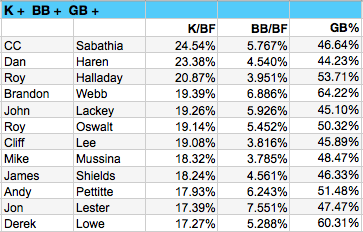
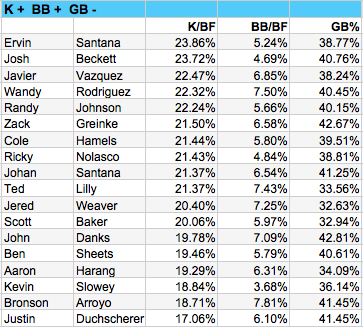

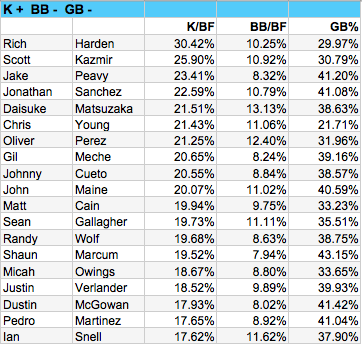

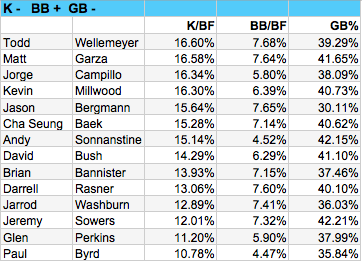

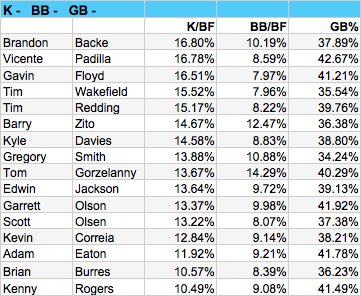
A valuable aspect of categorizing pitchers and listing K, BB, and GB rates is the ability to see comparable pitchers. Without applying similarity scores, one can see that John Lackey and Roy Oswalt are more alike than not with the latter producing slightly better walk and groundball rates. Both righthanders are fastball-slider-curveball types with Oswalt throwing a couple of miles-per-hour harder than Lackey. Oswalt gets the nod but probably not by as much as the differences in their career ERA+ (139 to 117).
Cliff Lee, Mike Mussina, and James Shields are bunched with the former getting the edge over the latter for his superior K and BB rates. Ervin Santana and Josh Beckett are hard-throwing (94.4 and 94.3 mph, respectively) righthanders with comparable K, BB, and GB rates. Dan Haren has a nearly identical K rate as Santana and Beckett but slightly better BB and GB rates. Although Javier Vazquez throws right and Wandy Rodriguez left, their fielding independent stats are not all that different even though the Houston starter is a relative unknown compared to the well-traveled, newly acquired Atlanta pitcher.
One of my favorite comps is Cole Hamels and Johan Santana, two of the best southpaws with plus-plus changeups. Ricky Nolasco may be just as good, or at least he was last year! The main difference between Jered Weaver and Scott Baker is that the latter has a roughly 20 percent better walk rate. Both righties are FB-SL-CH flyball types although Baker throws his heater about a mile per hour harder than Weaver.
A.J. Burnett and Chad Billingsley are two peas in a pod with respect to K, BB, and GB rates. Both throw gas and a hammer curve with A.J. lighting up the radar guns and his investment portfolio a bit more than his younger counterpart. When it comes to Felix Hernandez and Ubaldo Jimenez, there are more similarities (including the two hardest average fastballs in 2008) than differences as I first pointed out last July.
Other comps include Gil Meche and Johnny Cueto, Jesse Litsch and Braden Looper, Matt Garza and Gavin Floyd (and Todd Wellemeyer, Armando Galarraga, and Vicente Padilla, for that matter), and three back-to-back southpaw pairings: Dana Eveland and Jo-Jo Reyes (sporting similar FB-SL-CH repertoires), Nate Robertson and Mark Hendrickson, and, best of all, Jeff Francis and Jamie Moyer, two soft-tossing lefties with only 18 years separating them.
I will have a follow-up piece on Friday with a methodology to rank pitchers across all classifications.
Comments
Good stuff, Rich. What are the odds getting this on a 3D graph? Pictures are fun!
Posted by: Mitch at February 17, 2009 5:38 PM
Great stuff, Rich. Thanks. You gave us the K/BF and GB% averages in previous posts, but I don't see the BB/BF average here. Am I missing it? If not, what is it? I like to see how close to the average various pitchers are.
Posted by: Bob R. at February 18, 2009 4:08 AM
Thanks, Bob. The answer to your question is in the fifth paragraph (BB/BF = 7.89%).
Posted by: Rich Lederer at February 18, 2009 6:11 AM
Oops. Thank you. I can't believe I missed that. Well, actually I can imagine it; that's the problem.
Posted by: Bob R. at February 18, 2009 7:38 AM
Good stuff is right Rich.
By the way, based on the charts, it sure looks to me like BB and K rates have a LOT more to do with RA and ERA than GB rates.
And based on that, I'd much rather see a quadrant chart (like the first) just based solely on K and BB rates. 2 dimensions is a lot easier to work with on the Internet than 3-D.
Posted by: Russ at February 19, 2009 11:00 AM
Fantastic work. I'm going to dig into these later...
Posted by: Dave at February 20, 2009 10:40 AM